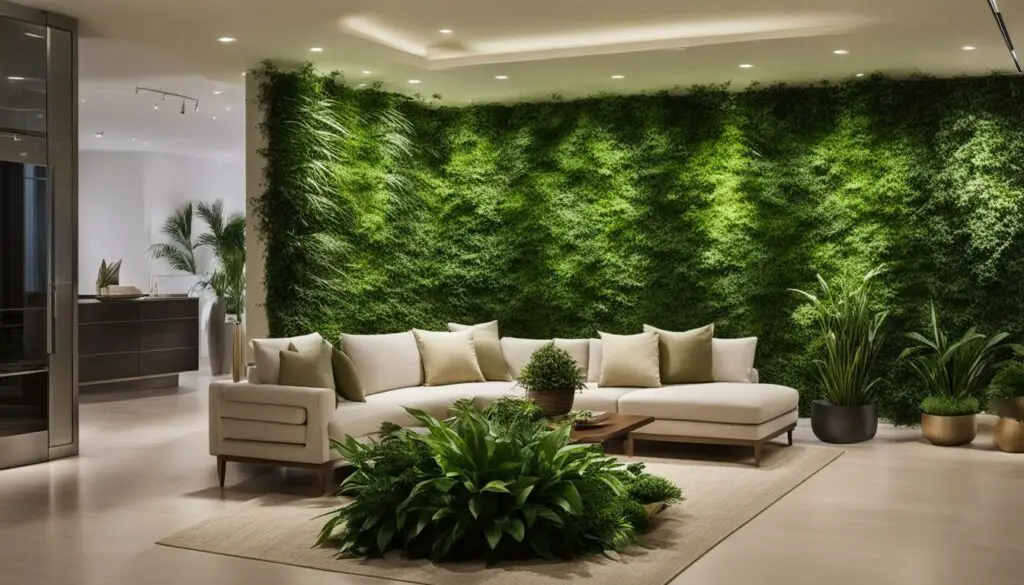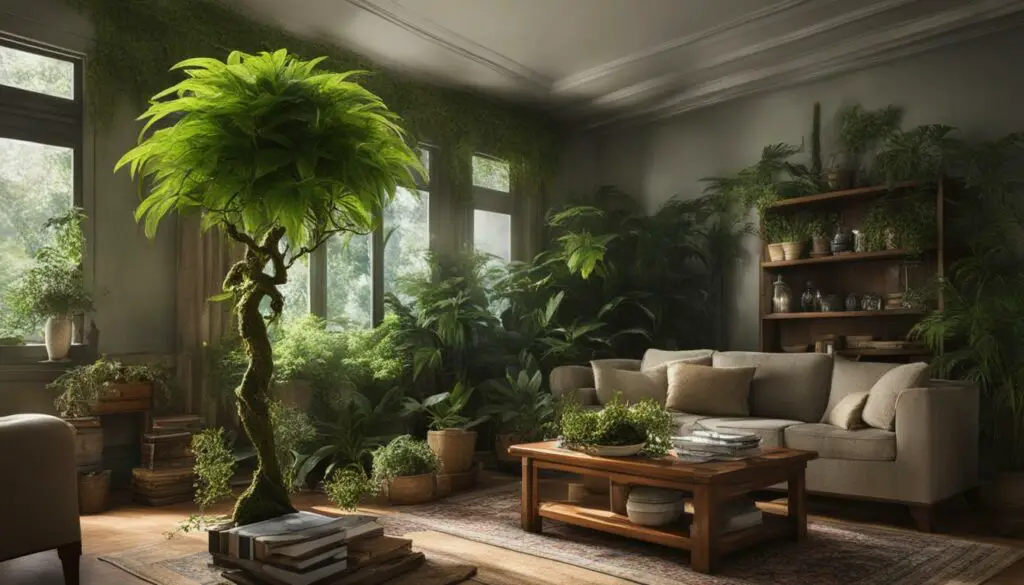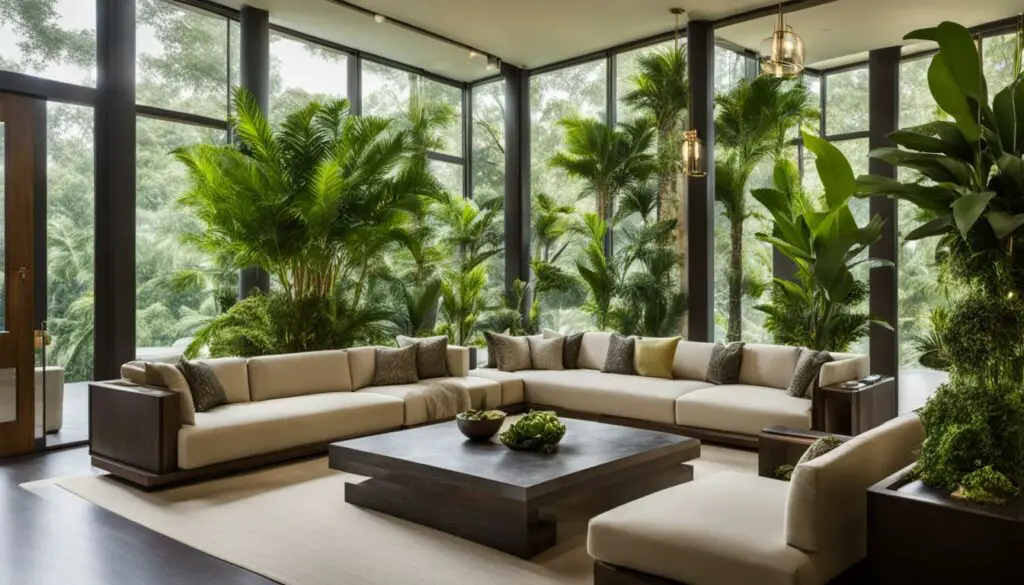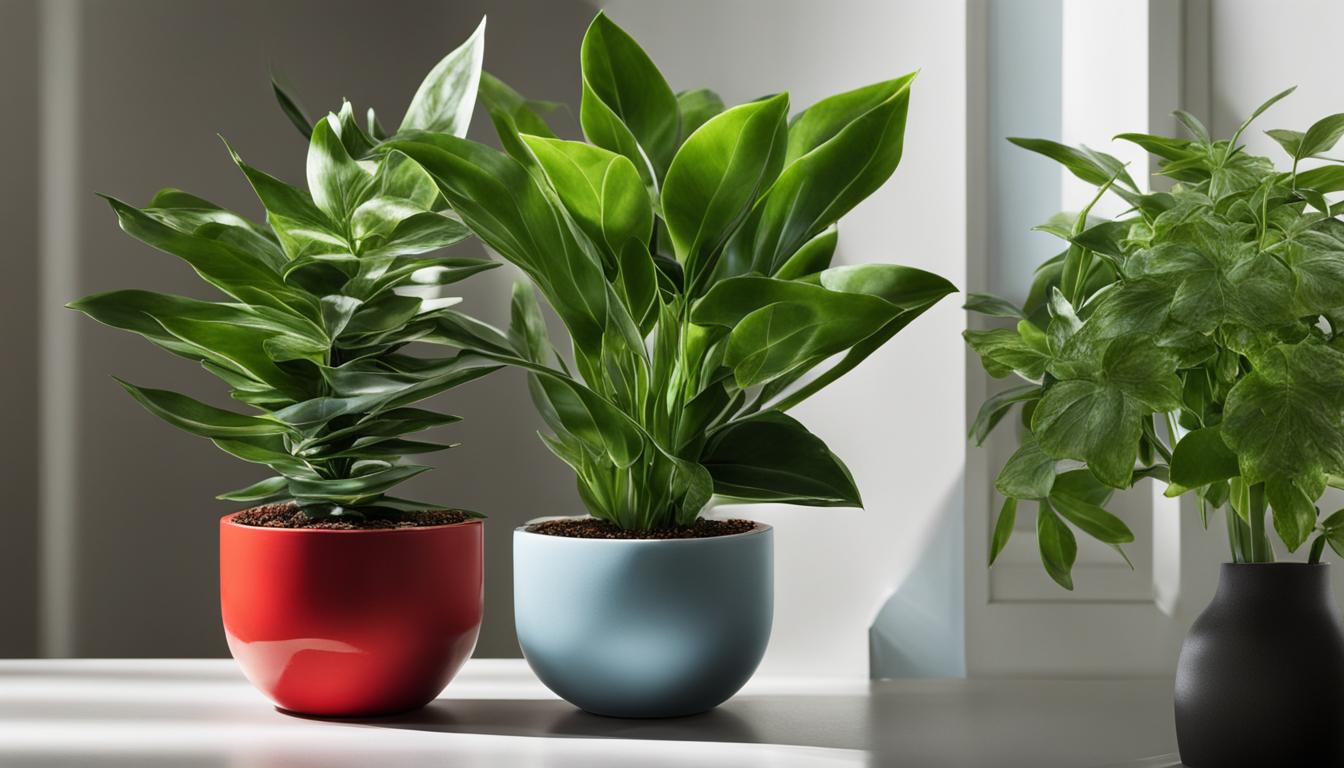Originally posted on October 31, 2023 @ 3:16 am
As the practice of Feng Shui continues to gain popularity, so do the debates surrounding the use of fake plants in this ancient art. Some practitioners swear by the benefits of incorporating real plants in their spaces while others argue that fake plants can be just as effective. So, are fake plants bad for Feng Shui?
Before we delve into that question, let’s explore the principles of Feng Shui and the relationship between energy flow and the objects we place in our environment.
Key Takeaways:
- The use of fake plants in Feng Shui practices is a topic of debate.
- Understanding the principles of Feng Shui and energy flow is crucial to evaluating the impact of fake plants.
- Personal preferences and individual contexts can also play a significant role in the use of fake plants in Feng Shui.
- Debunking myths and considering the benefits and drawbacks of both fake and real plants can help make informed decisions.
- Mindfully integrating both natural and artificial elements can create a balanced Feng Shui environment.
Understanding Feng Shui Principles
Before we can determine whether fake plants are bad for Feng Shui, let’s take a closer look at the principles of this ancient practice. Feng Shui guidelines emphasize creating a harmonious and balanced environment that promotes positive energy flow, or Qi (chi).
Using fake plants in Feng Shui practices is not inherently negative as long as they contribute to the overall harmony of the space. In fact, they can be useful for adding greenery and nature elements to areas with limited light or access to natural plants.
Colors and Materials in Feng Shui
Colors and materials play a significant role in Feng Shui and should be chosen mindfully when incorporating fake plants into a space. In general, earthy and natural hues such as green, brown, and beige are preferred over bright or artificial colors. Materials should also align with the natural elements of the environment, such as wood or clay planters instead of plastic or metal.
Shape and Placement of Fake Plants
When using fake plants in Feng Shui practices, consider the shape and placement carefully. Plants with soft and round shapes are associated with Yin energy, while those with pointed and sharp shapes are associated with Yang energy. A balance of both types of energy is important for overall harmony.
Regarding placement, fake plants should be placed strategically to enhance the flow of energy in a room. Areas such as corners or entryways can benefit from the addition of fake plants, but be careful not to clutter the space or block pathways.

“Integrating fake plants into Feng Shui practices requires thoughtful consideration of colors, materials, shapes, and placement. By aligning these elements with the natural environment, we can enhance the overall harmony and energy flow of a space.”
The Energy Flow in Feng Shui
Energy flow, also known as Qi (chi), is a crucial aspect of Feng Shui. It refers to the movement and circulation of energy within a space, which can affect the overall harmony and balance. In Feng Shui, it is believed that blocked energy can lead to stagnation and negative vibes, while free-flowing energy enhances the positive energy and well-being of an environment.
So, where do fake plants fall within this concept of energy flow in Feng Shui? Some argue that because fake plants do not have life force energy, they cannot contribute to the positive energy flow of a space. Others suggest that if placed mindfully, fake plants can still promote energy flow by adding an aesthetically pleasing element to the environment.
It’s important to remember that the placement of fake plants plays a significant role in their impact on energy flow. For example, placing fake plants in clustered or cluttered areas can hinder energy flow, while putting them in well-lit, open spaces can enhance energy movement.
The Relationship between Fake Plants and Energy Flow
When examining the relationship between fake plants and energy flow in Feng Shui, it’s essential to consider the material and quality of the plants. High-quality fake plants that closely resemble real plants can have a positive impact on energy flow, as they mimic the natural beauty and energy of real plants. In contrast, low-quality, visibly fake plants may have a negative impact on energy flow, as they disrupt the natural balance and harmony of an environment.
Additionally, incorporating a mix of real and fake plants can be a beneficial approach to enhancing energy flow in Feng Shui. Real plants bring natural life force energy and oxygen into a space, while fake plants can add beauty and consistency to the environment.

“Placing fake plants in clustered or cluttered areas can hinder energy flow, while putting them in well-lit, open spaces can enhance energy movement.”
In conclusion, the impact of fake plants on energy flow in Feng Shui is dependent on various factors. The quality and placement of the plants, as well as their relationship with real plants, all play a significant role in their contribution to energy flow. By incorporating fake plants mindfully and strategically, we can enhance the balance and harmony of our environment.
Achieving Balance in Feng Shui
Balance is a crucial aspect of Feng Shui that promotes harmony and well-being in a space. When it comes to incorporating fake plants, it’s important to consider how they can contribute to or disrupt the balance of a room or environment.
One way to achieve balance with fake plants is to use them sparingly, especially if they are noticeably artificial. A single high-quality fake plant placed in a room with natural light and other real plants can add a touch of greenery without overpowering the space.
| Do’s | Dont’s |
|---|---|
|
|
Another way to create balance is to choose fake plants that have a symbolic meaning in Feng Shui. For example, a fake money tree can represent wealth and prosperity, while a fake bamboo plant can promote luck and good fortune. These plants can be used as decor while also contributing to the overall Feng Shui of a space.
However, it’s important to note that fake plants should never become a substitute for adequate natural lighting or air purification. In fact, air-purifying real plants are highly recommended in Feng Shui practices to promote positive energy flow and overall well-being.

By understanding the principles of balance in Feng Shui and considering the use of fake plants mindfully, we can create harmonious spaces that promote positive energy flow and overall well-being.
Fake Plants vs. Real Plants in Feng Shui
Real plants have long been associated with positive energy and natural beauty in Feng Shui. However, incorporating live plants into a space can be challenging due to their maintenance and care requirements. This is where fake plants can offer an alternative solution.
While fake plants may lack the natural benefits of real plants, they do have some advantages. First, they require little to no maintenance, making them perfect for those who lack a green thumb. Second, they can be used in spaces where real plants cannot thrive due to low light or temperature.
However, it is important to note that fake plants do not have the same life force energy or Chi as real plants. Real plants are living things that can contribute to the overall energy and vitality of a space. In contrast, fake plants are lifeless objects that may not have the same impact on the feeling or atmosphere of a room.
When it comes to choosing between fake and real plants in Feng Shui practices, it ultimately depends on personal preference and the specific context. If you have the time and ability to care for real plants and appreciate their natural beauty, they may be the better option for promoting positive energy flow. However, if you are unable to care for live plants or need a low-maintenance solution, fake plants can be an acceptable alternative as long as they are used mindfully.

In general, it is best to use fake plants sparingly and only in areas where real plants cannot thrive. For example, an office with minimal natural light may benefit from the addition of a few small fake plants to bring in some greenery and natural elements. However, using too many fake plants can create a cluttered and unnatural feeling in a space.
To summarize, while real plants are generally preferred in Feng Shui practices, fake plants can be used mindfully as an alternative option. By considering personal preferences, the specific context, and the role of plants in promoting positive energy flow, individuals can make informed decisions about incorporating plants into their environment.
Debunking Myths about Fake Plants in Feng Shui
There are several common misconceptions about the use of fake plants in Feng Shui practices. One of the most prevalent myths is that they have inherently negative energy and can disrupt the flow of Chi (Qi) in a space. However, this is not necessarily true.
The energy flow in Feng Shui is determined by the arrangement and placement of objects and elements in a space, rather than their material composition. While it’s true that living plants can release oxygen and promote natural energy, this does not mean that fake plants have exclusively negative effects.
In fact, the use of artificial plants in Feng Shui can be beneficial in certain circumstances. For example, in areas with low natural light or where it may be challenging to maintain living plants, fake plants can provide a low-maintenance solution that still adds a touch of greenery and natural beauty to a space.
Another myth surrounding fake plants in Feng Shui is that they represent “dead” energy and can attract negative influences. However, this is not supported by the principles of Feng Shui. While it’s true that dead or dying plants should be removed from a space, the material composition of a plant does not determine its energy and influence.
Ultimately, the impact of fake plants on the Feng Shui of a space depends on their placement, arrangement, and intention. Mindful and purposeful placement of these artificial elements can contribute positively to the overall harmony and balance of a space.

“The important thing is not the material, but the intention behind it.”
This quote from Feng Shui expert Tisha Morris highlights the importance of approaching the use of fake plants in Feng Shui practices with intention and purpose. By considering the principles of balance and energy flow, and using fake plants in a mindful and purposeful way, you can create a harmonious environment that aligns with the principles of Feng Shui.
Integrating Fake Plants Mindfully in Feng Shui Practices
While some Feng Shui practitioners discourage the use of fake plants, others believe they can be incorporated mindfully to enhance the energy and aesthetics of a space. Here are some tips and considerations for using fake plants in Feng Shui practices:
- Choose high-quality, realistic-looking fake plants. Cheap, plastic-looking plants can disrupt the balance and energy flow of a space, so it’s important to select visually appealing options.
- Consider the placement of fake plants. In Feng Shui, plants are typically placed in the east or southeast corners of a room to promote growth and abundance. However, this may not be suitable for fake plants, as their energy differs from real plants. Instead, consider placing them in areas that could use a visual boost, such as a dark corner or a space that lacks natural light.
- Combine real and fake plants. If you prefer real plants but want to include some fake ones, you can create a harmonious blend by placing them in different parts of the room. This will allow you to enjoy the benefits of both options without disrupting the natural energy flow.
Remember, the goal of Feng Shui is to create a harmonious, balanced environment that promotes positive energy flow and overall well-being. By approaching the integration of fake plants thoughtfully and mindfully, you can enhance the energy and aesthetics of your space. Using fake plants in Feng Shui can be a creative way to achieve balance and incorporate natural elements into our homes and workplaces.

Creating a Balanced Feng Shui Environment
Now that we have explored the use of fake plants in Feng Shui practices, we can begin to consider how to create a balanced environment that incorporates both natural and artificial elements. Here are some practical tips:
Consider the Placement of Fake Plants
When incorporating fake plants into a space, consider the principles of Feng Shui and place them mindfully. Avoid cluttering corners or placing them in areas that disrupt energy flow. Instead, use them strategically to enhance the overall balance and harmony.
Mix Real and Fake Plants for Optimal Benefits
While real plants are preferred in Feng Shui practices, incorporating a mix of real and fake plants can provide optimal benefits. Real plants bring essential oxygen and natural beauty while fake plants offer low maintenance and consistent aesthetic appeal. Finding the right balance between the two can create a well-rounded and harmonious environment.
Choose High-Quality Fake Plants
When selecting artificial plants, choose high-quality options that look and feel realistic. Poorly made fake plants can disrupt the energy flow and appear cheap and tacky. Opt for ones that blend seamlessly with the natural environment and add to the overall aesthetic appeal.
Avoid Overuse of Fake Plants
While incorporating fake plants can be beneficial, be mindful not to overuse them. Too many fake plants can create a sterile and impersonal environment, disrupting the natural balance of a space. Use them sparingly and strategically to enhance the overall Feng Shui of a room or area.
By incorporating these tips and principles, we can create a balanced Feng Shui environment that incorporates both natural and artificial elements. Remember, the key is to approach the integration of fake plants thoughtfully and intentionally, keeping in mind the fundamental principles of Feng Shui.

Exploring Personal Preferences in Feng Shui
While Feng Shui principles provide guidance on the placement of objects in a space, personal preferences and intuition also play a significant role in achieving a harmonious environment. This includes the use of fake plants, which can be a source of controversy among practitioners. Some believe that even artificial plants can contribute to positive energy flow if they are aesthetically pleasing and create a sense of balance in the room.
However, it’s important to be mindful of how the placement of fake plants may affect the energy flow and balance in the room. According to Feng Shui principles, chi (energy) should be able to circulate freely, without any obstructions. Placing a fake plant in a position that blocks or hinders the movement of chi may lead to negative effects in the environment.
Ultimately, each individual must decide whether the inclusion of fake plants in their Feng Shui practices aligns with their personal preferences and goals. Some may find that incorporating natural plants that require care and attention better connects them with the environment. Others may prefer the convenience and low maintenance of artificial plants. Whatever the choice, it’s essential to approach it with intention and mindfulness to achieve a harmonious environment that supports overall well-being.

Conclusion
In conclusion, the use of fake plants in Feng Shui practices is a highly debated topic. While some practitioners believe that fake plants have negative effects on energy flow and disrupt the balance of a space, others suggest that they can contribute to the overall harmony and aesthetics if used mindfully.
It’s important to keep in mind the fundamental principles of Feng Shui, such as energy flow, balance, and personal preferences, when considering the use of fake plants in a space. By evaluating individual needs and goals, we can make informed decisions about whether to incorporate fake plants or stick with real plants.
When incorporating fake plants, it’s crucial to do so in a way that promotes balance and positive energy flow. Mindful placement and choice of fake plants can enhance the aesthetics and energy of a space, while haphazard use can disrupt it.
Overall, there is no one-size-fits-all answer to whether fake plants are bad for Feng Shui. The answer depends on individual circumstances and goals. By staying informed, considering personal preferences, and following basic Feng Shui principles, individuals can create harmonious spaces that promote well-being and positive energy flow.
FAQ
Are fake plants bad for Feng Shui?
Fake plants are not inherently bad for Feng Shui. It’s more about how they are used and the intention behind their placement.
What are the principles of Feng Shui?
The principles of Feng Shui involve creating a harmonious and balanced environment that promotes positive energy flow. It emphasizes the placement of objects and the arrangement of spaces to enhance well-being and prosperity.
How do fake plants affect energy flow in Feng Shui?
Fake plants can either enhance or disrupt the energy flow in a space depending on their placement and condition. It’s important to ensure that they are clean, well-maintained, and placed with intention to support positive energy flow.
Do fake plants contribute to achieving balance in Feng Shui?
Fake plants can contribute to achieving balance in Feng Shui as long as they are used mindfully. They can add greenery and natural elements to spaces where real plants may not thrive, helping to create a harmonious environment.
What are the differences between fake plants and real plants in Feng Shui?
Real plants are often considered to have stronger positive energy and connection to nature. However, fake plants can be a practical alternative in spaces that lack natural light or require low maintenance. It’s important to consider personal preferences and the specific needs of the environment.
What are the common myths about fake plants in Feng Shui?
Some common myths include that fake plants bring negative energy or block the flow of chi. In reality, their impact depends on their placement and condition, as well as the overall harmony of the space.
How can fake plants be integrated mindfully in Feng Shui practices?
Fake plants can be integrated mindfully by considering their placement in relation to the Bagua (Feng Shui energy map), keeping them clean and well-maintained, and regularly assessing their impact on the energy flow of the space.
How can I create a balanced Feng Shui environment with fake plants?
To create a balanced Feng Shui environment with fake plants, consider their placement in conjunction with other elements such as natural light, colors, and furniture arrangement. Maintain a clutter-free space and regularly assess the energy flow and overall harmony of the environment.
How do personal preferences influence the use of fake plants in Feng Shui?
Personal preferences and intuition play a significant role in Feng Shui. If you feel a positive connection to fake plants and they enhance your overall well-being in a space, they can be used in alignment with your personal sense of harmony.
What is the conclusion regarding fake plants in Feng Shui?
The use of fake plants in Feng Shui is subjective and depends on personal beliefs and preferences. While some practitioners believe that only real plants have positive energy, others suggest that fake plants can be used mindfully to enhance the overall harmony of a space. It’s important to be mindful of their placement and condition and consider the principles of Feng Shui in order to make an informed decision.
